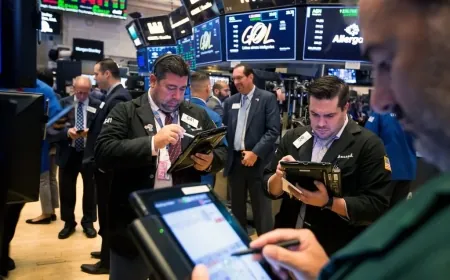Economic Outlook Dampens S&P 500's Recent Rally
Concerns Emerge as Corporate Earnings Projections Fall Below Expectations.

Despite a strong performance in the stock market this week, there are growing apprehensions about the profit outlook for Corporate America. A significant number of companies providing guidance for the upcoming quarter and beyond have been offering estimates that fall below analysts' expectations. This has resulted in a gauge of forward guidance, comparing corporate forecasts with Wall Street consensus, hitting its second-lowest point since 2019. While some remain optimistic, attributing it to potential conservatism in C-Suite signals, a darker interpretation suggests companies are treading cautiously in light of a challenging global landscape and the headwinds generated by the Federal Reserve's assertive interest-rate hikes.
In a week that witnessed a robust performance in the stock market, concerns have emerged regarding the earnings prospects for Corporate America. A noteworthy trend this earnings season has been the increasing number of companies providing guidance for the next quarter and beyond that falls short of analysts' projections. Data compiled by Bloomberg Intelligence reveals that a gauge of forward guidance, comparing corporate forecasts with Wall Street consensus, has reached its second-lowest point since 2019.
While some optimists may view this cautiously, speculating that C-Suite signals might ultimately prove to be overly conservative, a more somber interpretation suggests that companies are adopting a prudent approach as they grapple with a global economic outlook that raises concerns, compounded by the resistance posed by the Federal Reserve's aggressive interest-rate hikes.
Adam Phillips, Managing Director of Portfolio Strategy at EP Wealth Advisors, emphasizes the potential repercussions: "If there’s a lot of optimism based on forward projections and suddenly that starts to turn, then it doesn’t bode well for stock prices. But we’re seeing more signs that cracks are beginning to form from tighter financial conditions and profit outlooks. Some analysts have been slower to come to terms with this."
Approximately only a quarter of S&P 500 companies provide quarterly guidance, with just over half offering it on an annual basis, primarily in the technology and discretionary sectors. While earnings for most Big Tech companies have met or exceeded expectations, the outlook has dimmed alongside the general increase in borrowing costs.
The S&P 500 saw a notable gain of 5.9% this week, driven in part by weaker-than-expected US jobs data. This event bolstered confidence that the Federal Reserve might have concluded its tightening measures, leading to a significant drop in Treasury yields.
The gauge measuring momentum in earnings guidance, derived from factors like the ratio of increased versus reduced guidance, is currently at its lowest since the first quarter. With the exception of that period, it is the lowest it's been since 2019, according to Bloomberg Intelligence data.
This downbeat signal implies that the anticipated expansion in profits may not materialize as swiftly as initially anticipated. The S&P 500 is currently projected to exhibit earnings growth of 3.2% in the third quarter, marking the end of a three-quarter streak of contracting profits.
Several factors contribute to corporate caution, ranging from geopolitical tensions in the Middle East to persistent inflation and a lack of economic clarity. The Atlanta Fed's GDPNow model forecasts a slowdown in fourth-quarter real GDP growth to a 1.2% annual rate, down from a 4.9% pace in the preceding three months.
Sell-side analysts have taken note of this trend, reducing their fourth-quarter EPS views by 1.9% since October 6, as reported by Deutsche Bank AG. This is a departure from the typical pattern, where the view on the following reporting cycle tends to see a median drop of 1%, based on Deutsche Bank data dating back to 2010.
Justin Burgin, Director of Equity Research at Ameriprise Financial, asserts that the waning confidence in companies' profit outlook is the primary factor behind the lackluster response to third-quarter earnings. S&P 500 firms that fell short of analysts' earnings estimates have underperformed the benchmark's performance by an average of 3.8% a day after the results, marking the weakest showing in a year, according to Bloomberg Intelligence.
Also Read: Stock Market Optimism as Federal Reserve Hints at Rate Hike Pause































































